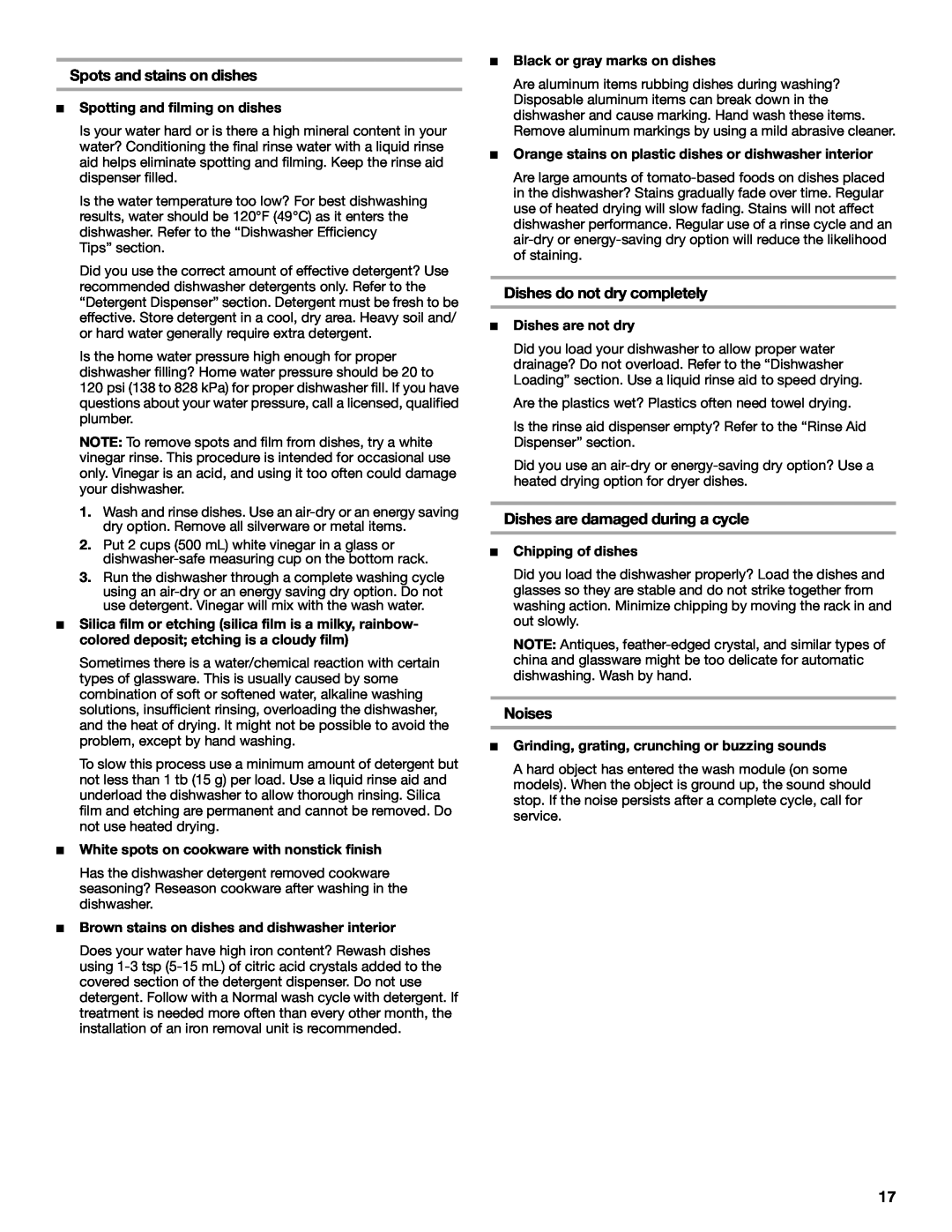
Spots and stains on dishes
■Spotting and filming on dishes
Is your water hard or is there a high mineral content in your water? Conditioning the final rinse water with a liquid rinse aid helps eliminate spotting and filming. Keep the rinse aid dispenser filled.
Is the water temperature too low? For best dishwashing results, water should be 120°F (49°C) as it enters the dishwasher. Refer to the “Dishwasher Efficiency
Tips” section.
Did you use the correct amount of effective detergent? Use recommended dishwasher detergents only. Refer to the “Detergent Dispenser” section. Detergent must be fresh to be effective. Store detergent in a cool, dry area. Heavy soil and/ or hard water generally require extra detergent.
Is the home water pressure high enough for proper dishwasher filling? Home water pressure should be 20 to
120psi (138 to 828 kPa) for proper dishwasher fill. If you have questions about your water pressure, call a licensed, qualified plumber.
NOTE: To remove spots and film from dishes, try a white vinegar rinse. This procedure is intended for occasional use only. Vinegar is an acid, and using it too often could damage your dishwasher.
1.Wash and rinse dishes. Use an
2.Put 2 cups (500 mL) white vinegar in a glass or
3.Run the dishwasher through a complete washing cycle using an
■Silica film or etching (silica film is a milky, rainbow- colored deposit; etching is a cloudy film)
Sometimes there is a water/chemical reaction with certain types of glassware. This is usually caused by some combination of soft or softened water, alkaline washing solutions, insufficient rinsing, overloading the dishwasher, and the heat of drying. It might not be possible to avoid the problem, except by hand washing.
To slow this process use a minimum amount of detergent but not less than 1 tb (15 g) per load. Use a liquid rinse aid and underload the dishwasher to allow thorough rinsing. Silica film and etching are permanent and cannot be removed. Do not use heated drying.
■White spots on cookware with nonstick finish
Has the dishwasher detergent removed cookware seasoning? Reseason cookware after washing in the dishwasher.
■Brown stains on dishes and dishwasher interior
Does your water have high iron content? Rewash dishes using
■Black or gray marks on dishes
Are aluminum items rubbing dishes during washing? Disposable aluminum items can break down in the dishwasher and cause marking. Hand wash these items. Remove aluminum markings by using a mild abrasive cleaner.
■Orange stains on plastic dishes or dishwasher interior
Are large amounts of
Dishes do not dry completely
■Dishes are not dry
Did you load your dishwasher to allow proper water drainage? Do not overload. Refer to the “Dishwasher Loading” section. Use a liquid rinse aid to speed drying.
Are the plastics wet? Plastics often need towel drying.
Is the rinse aid dispenser empty? Refer to the “Rinse Aid Dispenser” section.
Did you use an
Dishes are damaged during a cycle
■Chipping of dishes
Did you load the dishwasher properly? Load the dishes and glasses so they are stable and do not strike together from washing action. Minimize chipping by moving the rack in and out slowly.
NOTE: Antiques,
Noises
■Grinding, grating, crunching or buzzing sounds
A hard object has entered the wash module (on some models). When the object is ground up, the sound should stop. If the noise persists after a complete cycle, call for service.
17
